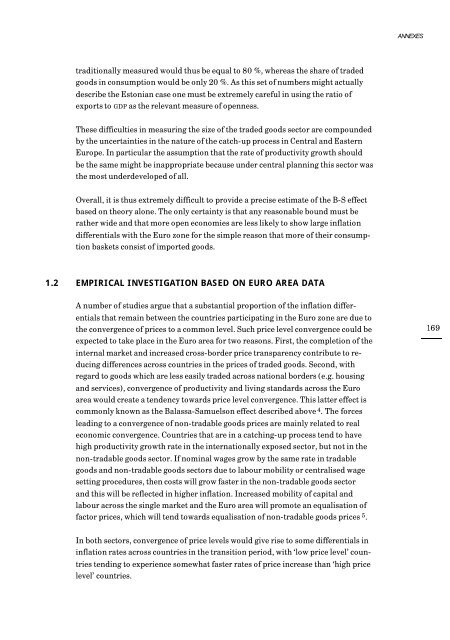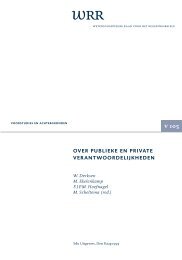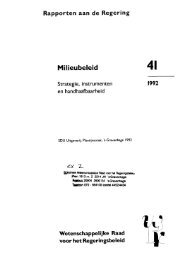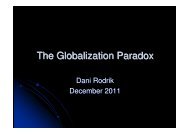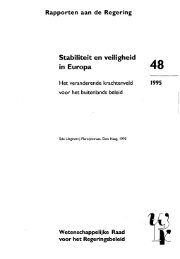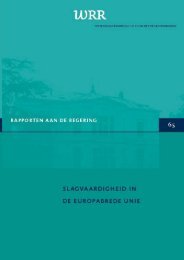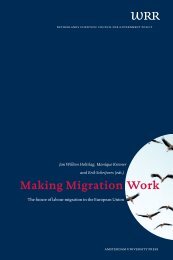w 109 long-run economic aspects of the european union's eastern ...
w 109 long-run economic aspects of the european union's eastern ...
w 109 long-run economic aspects of the european union's eastern ...
You also want an ePaper? Increase the reach of your titles
YUMPU automatically turns print PDFs into web optimized ePapers that Google loves.
ANNEXEStraditionally measured would thus be equal to 80 %, whereas <strong>the</strong> share <strong>of</strong> tradedgoods in consumption would be only 20 %. As this set <strong>of</strong> numbers might actuallydescribe <strong>the</strong> Estonian case one must be extremely careful in using <strong>the</strong> ratio <strong>of</strong>exports to GDP as <strong>the</strong> relevant measure <strong>of</strong> openness.These difficulties in measuring <strong>the</strong> size <strong>of</strong> <strong>the</strong> traded goods sector are compoundedby <strong>the</strong> uncertainties in <strong>the</strong> nature <strong>of</strong> <strong>the</strong> catch-up process in Central and EasternEurope. In particular <strong>the</strong> assumption that <strong>the</strong> rate <strong>of</strong> productivity growth shouldbe <strong>the</strong> same might be inappropriate because under central planning this sector was<strong>the</strong> most underdeveloped <strong>of</strong> all.Overall, it is thus extremely difficult to provide a precise estimate <strong>of</strong> <strong>the</strong> B-S effectbased on <strong>the</strong>ory alone. The only certainty is that any reasonable bound must bera<strong>the</strong>r wide and that more open economies are less likely to show large inflationdifferentials with <strong>the</strong> Euro zone for <strong>the</strong> simple reason that more <strong>of</strong> <strong>the</strong>ir consumptionbaskets consist <strong>of</strong> imported goods.1.2 EMPIRICAL INVESTIGATION BASED ON EURO AREA DATAA number <strong>of</strong> studies argue that a substantial proportion <strong>of</strong> <strong>the</strong> inflation differentialsthat remain between <strong>the</strong> countries participating in <strong>the</strong> Euro zone are due to<strong>the</strong> convergence <strong>of</strong> prices to a common level. Such price level convergence could beexpected to take place in <strong>the</strong> Euro area for two reasons. First, <strong>the</strong> completion <strong>of</strong> <strong>the</strong>internal market and increased cross-border price transparency contribute to reducingdifferences across countries in <strong>the</strong> prices <strong>of</strong> traded goods. Second, withregard to goods which are less easily traded across national borders (e.g. housingand services), convergence <strong>of</strong> productivity and living standards across <strong>the</strong> Euroarea would create a tendency towards price level convergence. This latter effect iscommonly known as <strong>the</strong> Balassa-Samuelson effect described above 4 . The forcesleading to a convergence <strong>of</strong> non-tradable goods prices are mainly related to real<strong>economic</strong> convergence. Countries that are in a catching-up process tend to havehigh productivity growth rate in <strong>the</strong> internationally exposed sector, but not in <strong>the</strong>non-tradable goods sector. If nominal wages grow by <strong>the</strong> same rate in tradablegoods and non-tradable goods sectors due to labour mobility or centralised wagesetting procedures, <strong>the</strong>n costs will grow faster in <strong>the</strong> non-tradable goods sectorand this will be reflected in higher inflation. Increased mobility <strong>of</strong> capital andlabour across <strong>the</strong> single market and <strong>the</strong> Euro area will promote an equalisation <strong>of</strong>factor prices, which will tend towards equalisation <strong>of</strong> non-tradable goods prices 5 .169In both sectors, convergence <strong>of</strong> price levels would give rise to some differentials ininflation rates across countries in <strong>the</strong> transition period, with ‘low price level’ countriestending to experience somewhat faster rates <strong>of</strong> price increase than ‘high pricelevel’ countries.


